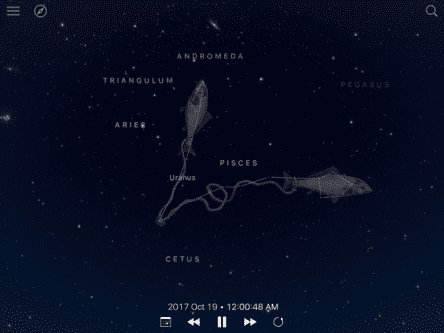Highlights of the October Sky


• Oct 3rd – On this day in 1942, the first V-2 rocket was launched. The V-2 was the first long-range guided ballistic missile and was developed in Germany during WWII to attack Allied cities in Belgium, the United Kingdom, France, the Netherlands, and even Germany itself (1945, Battle of Remagen ). After the war, the United States captured various V-2 rockets, along with one of the rocket’s scientists, Werner Von Braun. The missile technology, along with Von Braun’s expertise, was the basis for our first ventures into space.

• Oct 4 – The space age officially begins with the successful launch of Soviet Russia’s Sputnik 1, the first artificial satellite, on this day in 1957.

• Oct 5 – During the hours of dawn, look for a very close pairing of the planets Venus and Mars in the eastern sky. The two planets appear only 1/4 of a degree apart in the sky.
Full moon officially occurs at 1:40 P.M. CDT.

• Oct 6 The waning gibbous moon appears just 4 degrees to the south of Uranus
• Oct 7 The red planet Mars is at aphelion, its most distant point from the Sun, 154.9 million miles away from our local star at 5:00 P.M. CDT.
• Oct 9 The Moon is at perigee, the closest point in its orbit around the Earth, 227,953 miles away, at 12:55 A.M. The Moon lies amid the Hyades star cluster in our morning sky within the constellation of Taurus.

Kepler’s Supernova was observed this day in 1604. Kepler’s supernova, named in honor of astronomer Johannes Kepler, is the most recent supernova to have been seen by the naked eye within our own Milky Way Galaxy. The supernova was what is known as a Type Ia supernova event. These kinds of supernovae involve a white dwarf star interacting gravitationally with a companion star of another type. The white dwarf steals material from the companion and, thus, pushes its mass above a critical point, triggering a massive explosion that completely obliterates the white dwarf.
• Oct 12 The last quarter Moon officially occurs at 7:25 A.M. CDT.
• Oct 14 Free public star party at Pinnacle Mountain State Park’s visitor center, 7:30 P.M. to 10:00 P.M. For details, please visit www.caasastro.org.

• Oct 15 The Moon is south of the star Regulus, in the constellation of Leo, at 6:00 A.M. CDT. Look for Venus and Mars below it.
• Oct 17 During the predawn hours, look for a waning crescent Moon that is very close to the planets Venus and Mars in the eastern sky.

• Oct 19 The planet Uranus is at opposition at 1:00 P.M. Opposition of an outer planet occurs when the Earth overtakes the planet in its orbit around the Sun so that the outer planet appears on one side of our sky and the Sun on the other side. Seen from “above” the solar system, you would see a configuration like this: Sun->Earth->Uranus. Opposition is the best time to observe a planet as it is rising just as the Sun is setting and, thus, is up all night, and because it is at its closest distance to the Earth. With the aid of a star chart and binoculars, you can see Uranus as a pale, greenish dot just NW of the star Omicron Piscium within the constellation of Pisces this evening at around 12:00 A.M. in the SE.

• Oct 21 The peak of the Orionid Meteor Shower occurs just before dawn. The Orionids are not known for producing large numbers of meteors (20 meteors per hour at peak times under a dark sky) but, unlike many other meteor showers this year, this one will peak during favorable conditions as the crescent Moon will set during the early evening. Look just before midnight and you may be lucky enough to catch sight of one or two Earth-grazers, “shooting stars” that fly overhead from just below the horizon, often have long, bright tails, and follow a course that is nearly parallel with the Earth’s atmosphere. If you see any Orionids, you are looking at fragments of Halley’s Comet, the parent body for this meteor shower.

• Oct 24 The Moon is just 3 degrees north of Saturn this evening. One degree is the width of your pinky finger held out at arm’s length (the full moon is only a half a degree in apparent width).
The Moon is at apogee, its most distant point in its orbit around the Earth, at a distance of 251,751 miles at 9:26 P.M. CDT.

• Oct 27 First quarter Moon officially occurs at 5:22 P.M. CDT.
The Central Arkansas Astronomical Society, the UALR Department of Physics and Astronomy, and The Arkansas Innovation Hub will host an International Observe the Moon Night event at the Hub, 201 E. Broadway, NLR., from 7:30 P.M. to 10:00 P.M. (with a backup date of October 28th in case of rain or clouds). The event consists of lunar observing with telescopes, indoor activities, food trucks, and music. It is free and family friendly.

• Oct 31 Happy Halloween! Aside from ghosts and goblins, keep an eye out for bright Halloween Fireballs. These are very bright meteors that often appear yellow-orange in color and tend to move slowly across the sky (relatively speaking anyways). Halloween Fireballs can be seen from late October on up until the middle of November and are associated with the Taurid Meteor Shower, which peaks next month.
